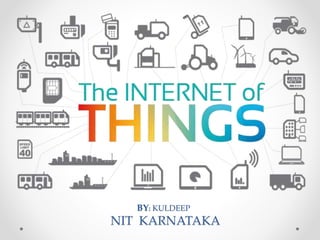
iot seminar topic
- 2. Plan of presentation • Evolution of Internet • What is Internet of Things ? • How IoT Works ? • Current Status & Future Prospect of IoT • The Future of IoT • Applications of IoT • Technological Challenges Of IoT • References
- 4. Internet of Boffins • This was the era when ARPANET (Advanced Research Project Agency Network) carried its first data packet in 1969. It was the first network to use TCP/IP. The other major inventions such as Telnet in 1974, Ethernet in 1980, GOSIP in 1990 and a full text web search engine in 1994 followed the trend. This era is called ‘Internet of Bowfins’ since in this era internet was in a stage of early evolution and research
- 5. Internet of Geeks • ‘Internet of Geeks’ era started with the proposal of IPv6. It was the latest revision of the internet protocol. The communication protocol provides identification and location system for computers on networks and routes traffic across internet. The popular internet services started taking roots in this era. Amazon.com started its first online retail service in 1995. • Hotmail started its free web based email service in 1996, followed by Google search in 1998. PayPal started its first internet payment service in 1998. Internet penetration was low in the market until 2000.
- 6. Internet of masses • ‘Internet of masses’ era started with the Dot- com bubble burst in 2000. In the starting of this era Dotcom bubble burst led to high growth in stock markets due to increasing use of internet in the industrial sector. In this era many people across the globe started using internet. Social networking sites came into existence. In 2001 Wikipedia came into existence followed by Facebook in 2004, further followed by YouTube, Twitter and WikiLeaks in the consecutive years.
- 7. Mobile Internet • ‘Mobile Internet’ era refers to access to the Internet via cellular phone service provider. The era got a boost with introduction of smartphones which gave a fast working internet on phones. This was the era from 2007-2011. There was steep rise in the use of internet by the people round the globe due to the mobile internet.
- 8. Internet of Things • ‘Internet of Things’ refers to an era where things can be connected to each other using internet
- 11. • The Internet of Things allows people and things to be connected Anytime, Anyplace, with Anything and Anyone, ideally using Any network and Any service (6A). • This implies addressing elements such as Convergence, Content, Collections (Repositories), Computing, Communication, and Connectivity (6C) in the context.
- 14. How to IoT Work • The Internet of Things (IoT), also sometimes referred to as the Internet of Everything (IoE), consists of all the web-enabled devices that collect, send and act on data they acquire from their surrounding environments using embedded sensors, processors and communication hardware. These devices, often called "connected" or "smart" devices, can sometimes talk to other related devices, a process called machine-to-machine (M2M) communication, and act on the information they get from one another. Humans can interact with the gadgets to set them up, give them instructions or access the data, but the devices do most of the work on their own without human intervention. Their existence has been made possible by all the tiny mobile components that are available these days, as well as the always online nature of our home and business networks.
- 22. Current Status & Future Prospect of Iot
- 23. The Future of IoT "The Sky's not the limit. It's only the beginning with IoT."
- 40. “How much more IoT can do is only left to your imagination”
- 41. TECHNOLOGICAL CHALLENGES OF IoT • Scalability • Security • Technological Standardization • Interoperability • Discovery • Software complexity • Data volumes and interpretation • Power Supply • Interaction and short range communication • Wireless communication • Fault tolerance
- 43. References • https://www.nebula.co.za/2016/11/11/risks- disadvantages-iot-overcome/ • https://www.internetsociety.org/doc/iot-overview • http://www.happiestminds.com/Insights/internet-of- things/ • http://www.webopedia.com/TERM/I/internet_of_things.ht ml • https://www.sap.com/india/solution/internet-of- things.html • www.google.com • www.youtube.com
- 44. THANK YOU